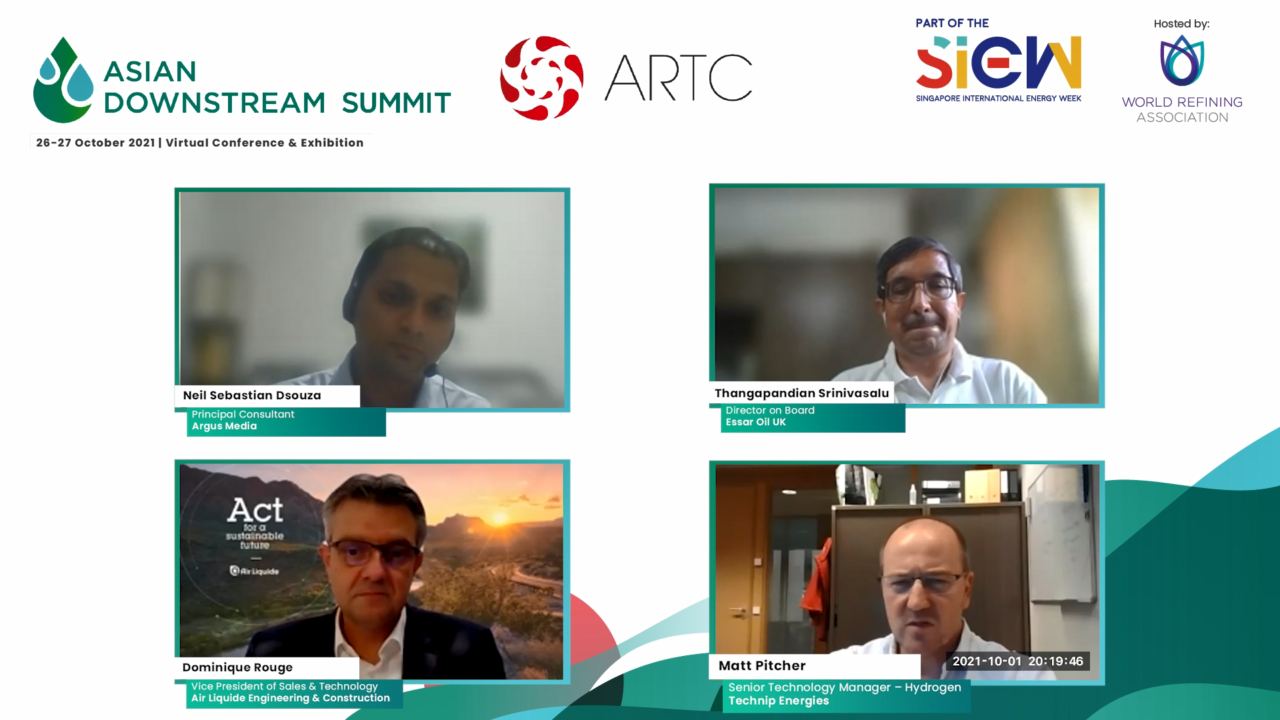Hydrogen Panel: No “one size fits all” solution
Decarbonisation is the name of the game, for the refining and petrochemicals industry – refiners face an ever-growing demand to meet net-zero requirements. On the other hand of this challenge, refiners also have to contend with operating in a lower margin environment.
Gathered at the virtual Asian Refining Technology Conference, industry leaders discussed avenues available to the sector in light of these challenges, and navigating the twin challenges of decarbonisation costs and operating in a low-margin environment. The panel discussion was led by Neil Sebastian Dsouza, Principal Consultant (Energy Economics and Policy, Asia-Pacific and the Middle East), Argus Media.

Said Thangapandian Srinivasalu, Director on Board of Essar Oil, “There are two challenges here. On the demand side, mature markets have had a flat sort of fuel consumption for the last couple of years, and I think we have peaked, and the demand will start coming down. On the margin side of things, there has hardly been any major investment in the refining sector. So at least for the next four to five years, I see a good margin period because the balance matches when the demand comes down, and alternate fuels will reach the same level.
But the refineries have to start working towards transition today, because any major project takes anywhere from four to five years. If you’re looking at the hydrogen project or biodiesel project you’re got a period of anywhere from 36 to 48 months.”
Echoing Srinivasalu’s statement was Dominique Rouge, Vice President of Sales & Technology, Air Liquide Engineering & Construction.
“I think what’s important as an avenue to work on is on the demand side,” he said, “to be sure that we have the proper regulations and framework, but also the proper social acceptance and communication. One key point will be the flexibility of the solutions proposed, a portfolio of technologies for customers… It can be a mix of green hydrogen or carbon capture, carbon sequestration, electrification… This is something we can propose, to help customers find their way through this uncertain environment.”
However, solutions proposed for dealing with the challenge of balancing demand would likely have to differ depending on the time frame proposed, said Matt Pitcher, Senior Technology Manager – Hydrogen, Technip Energies. There could be a significant difference between five and 30 years, and looking at things from a macro lens would mean, ultimately, that refiners will need to diversify business models in order to adapt and survive, especially as fossil fuel demand could be expected to decline to nominal values.
“Obviously, you can move from fossil fuels to renewable fuels,” Pitcher shared. “I think ultimately you’re looking at a shift from the fossil fuel business to petrochemical feedstock, and a general focus, short to long term, is on carbon utilization – and so you’re looking at the possibility of diversifying business from fossil fuels. In the short term, though, I think you’re looking at the low-hanging fruit type of projects where you’re looking at efficiency, electrification, ways to increase complexity, versatility, the refinery in general.”
Currently, refineries are in the midst of this transition, and are looking at integration into the petrochemical space. But as Dsouza put it, there is no one size fits all solution. In transitioning to low carbon or hydrogen solutions, what are the ways around challenges that the industry will face?
That, Pitcher admitted, is challenging.
“We haven’t quite cracked the nut on how to fit green hydrogen into a refinery on the large scale yet, and scalability is certainly at play here,” he said. “Up until now, green hydrogen has been sort of engineered as a package solution, a containerized solution; and people often go straight from green hydrogen to electrolysis, and forget that green hydrogen is also from biomaterials as long as notably sourced. So if you’re looking at biofuel production, there are opportunities with the off gases or the byproducts of those units to take that bio source material, and convert that directly into hydrogen and reasonably interesting quantities. It’s easy to forget the green hydrogen doesn’t have to be electrolysis and there are opportunities elsewhere in that green space.”
But before the industry can transition to green, it has to take other issues into account – a carbon budget, for example. Blue hydrogen is a better fit at the moment, concluded Dsouza, and the industry will have need of the blue before it can transition to the green.
“We can see that blue hydrogen and CO2 capture technology has strong potential for improvement,” said Rouge. “We need to address the full portfolio, and there is no one solution that fits all scenarios. So it’s a lot of education, a lot of work, a lot of communication, and by different countries and societies. Of course, political support should be there. On the net zero trajectory, there has been an extensive communication of these plans done over the last few months, because it’s very recent history. And that has to be really clear for everybody and communicated extensively. That’s clearly a starting point. And I think we have a responsibility there.”
Missed out on this session during ARTC 2021? Register and watch it HERE!
**complimentary access for refiners only**